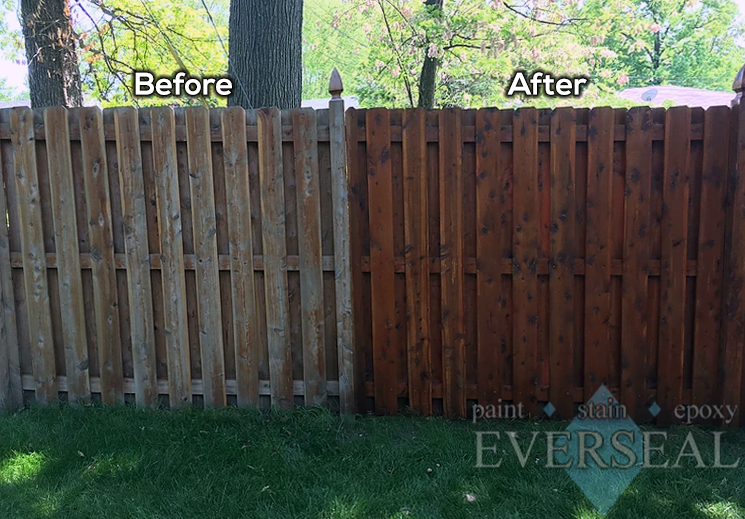Boost Your Outside Space with Expert Fence Staining Services!
Boost Your Outside Space with Expert Fence Staining Services!
Blog Article
Just How to Select the Right Fencing Discoloration for Your Property
When it comes to improving the appearance and toughness of your home's fence, picking the best tarnish is a critical decision that requires mindful consideration. With a myriad of options readily available in the market, each providing to different wood types, shades, and openness degrees, the process can swiftly become overwhelming. Making an enlightened choice can significantly affect the total appearances and durability of your fencing. So, how can you guarantee that you pick the ideal fence tarnish that aligns with your home's design and maintenance needs? Let's explore some crucial elements to assist you in this decision-making procedure.
Recognizing Timber Kind
To pick the appropriate fence discolor, it is vital to have a thorough understanding of the different types of timber typically utilized for fencing. When selecting a fence discolor, it is crucial to consider the type of wood being made use of to make certain compatibility and optimum defense. Recognizing the characteristics of various wood kinds will certainly aid you make an informed decision when it comes to choosing the ideal fence discolor for your building.
Selecting the Right Color
Choosing a proper color for your fencing tarnish is a critical decision that substantially affects the overall visual charm of your residential property. The color you choose need to enhance the design of your home, mix sympathetically with the surroundings, and reflect your personal taste. When selecting a shade, take into consideration the existing shade scheme of your residential or commercial property. For an all-natural appearance, earthy tones like browns, greens, or grays work well. These colors can aid the fence mix into the landscape and develop a cohesive look. If you like a more contemporary or strong appearance, think about opting for darker tones like black or deep charcoal for a striking comparison. Lighter colors such as whites or light grays can make a fence appear larger and include a touch of sophistication to your home. Eventually, the best shade option will enhance the beauty of your fencing and elevate the total visual allure of your home.

Taking Into Consideration Transparency Levels
When choosing the appropriate color for your fencing stain, another vital element to take into consideration is the level of transparency that will certainly best fit your residential property's aesthetic and maintenance needs. Transparency levels in fence discolorations typically come under 3 groups: transparent, semi-transparent, and strong. Transparent spots permit the all-natural charm of the timber to reveal via while providing minimal protection versus the aspects. They are optimal for brand-new or well-maintained fences where showcasing the timber grain is a priority. Semi-transparent spots offer an equilibrium between shade enhancement and protection, permitting some timber grain to be noticeable while giving modest securing from UV rays and moisture. Solid spots, on the various other hand, give one of the most protection as they totally cover the timber with an opaque finish. These appropriate for older fencings or those looking for significant defense or color adjustment. Take into consideration the degree of direct exposure your fence encounters, the wanted upkeep frequency, and the visual you desire to accomplish when picking the appropriate transparency level for your fencing discolor.
Reviewing Maintenance Requirements
Thinking about the longevity and maintenance of your fence, examining the upkeep needs is essential in figuring out one of the most ideal fencing tarnish for your residential property. The degree of maintenance needed for your fence can differ depending on aspects such as the type of wood, climate condition in your area, and your individual choices.
When reviewing upkeep demands, it is vital to take into consideration the toughness of the fence stain. Some stains call for even more constant reapplication than others, so selecting a discolor with a longer life expectancy can help lower the general maintenance needs of your fence (Fence Staining Service). In addition, elements such as resistance to UV rays, water, and mold can influence exactly how frequently you require to re-stain your fencing

Testing Examples Prior To Application
Prior to using any fence tarnish, it is a good idea to carry out example examinations to ensure compatibility with the timber and desired aesthetic outcome. Checking examples enables you to evaluate how the tarnish will certainly connect with the specific type of wood used in your fencing, as various woods can absorb discolorations in different ways. To begin, choose a tiny unnoticeable area of the fencing to use the stain examples.
Verdict
Finally, choosing the appropriate fencing tarnish for your residential or commercial property entails recognizing the timber type, picking the appropriate shade, her latest blog taking into consideration transparency degrees, assessing maintenance demands, and screening examples before application (Fence Staining Service). By taking these variables into consideration, you can make certain that your fencing tarnish enhances your residential or commercial property while providing the necessary defense and longevity. Make a notified decision to improve the appearance and longevity of your fence
Report this page